
|
|
FYBUSH.COM/SITE OF THE WEEK
NEEDS YOUR SUPPORT! (AND YOU CAN GET A FREE TOWER SITE CALENDAR
IF YOU PLEDGE NOW...) CLICK HERE
TO LEARN MORE...
January 1-8, 2004
WGN (and WCPX), Chicago
As we enter a new year, we wrap up our recap of our early November visit to Chicago and its many exciting broadcast facilities. When we left you last week, we had just begun our second day in the Windy City with a visit to the new Clear Channel studios and a live Paul Harvey broadcast - and our morning was far from over. The next stop: the tallest building in America, the Sears Tower - alas, not for a rooftop visit (it was a Friday and the transmitter tenants only have roof access on Mondays and Tuesdays), but for at least a quick peek at one of the newest installations there.
This part of the 98th floor was once home to Sears executive offices, back when Sears owned the building, and we're told it once had lavish wood-panelled walls and fancy flooring. With the coming of DTV and the need for more transmitter space in the building, much of 98 is now transmitter space, including the big room at the end of the hall that's now Pax's WCPX-TV (Channel 38) and WCPX-DT (Channel 43), which moved over from the Hancock a year ago. Two fun facts here: first, WCPX-DT pumps its multicasting as hard as anyone in America, running six multicast channels that include all four time zone feeds of Pax TV, Worship TV and the FamilyNet service that succeeded the old religious programming that ran on channel 38 in its WCFC-TV days; second, the leases at Sears don't include the window space in each room - that's leased out separately for things like STLs and traffic cameras.
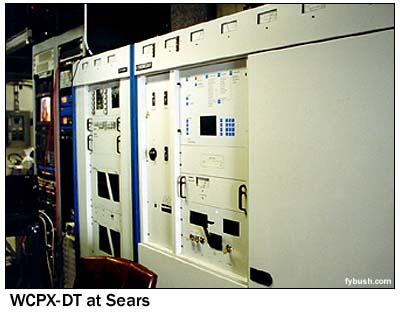 |
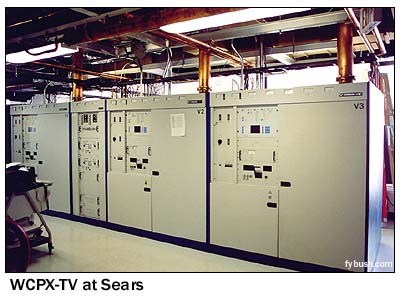 |
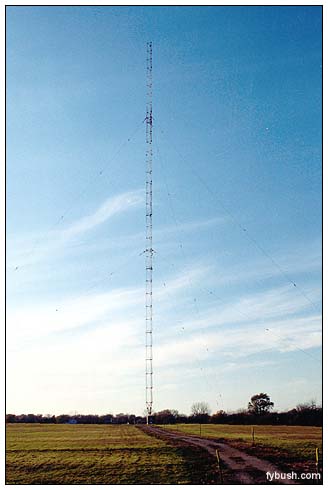 The
98th floor has several other new tenants as well: it's where
WGN-DT (Channel 19) and WFLD-DT (Channel 31) moved in when they
launched service from Sears (their analog facilities, as we saw
last week, remain at Hancock.)
The
98th floor has several other new tenants as well: it's where
WGN-DT (Channel 19) and WFLD-DT (Channel 31) moved in when they
launched service from Sears (their analog facilities, as we saw
last week, remain at Hancock.)
From Sears, it's back in a cab and over to the Sun-Times building alongside the Chicago River on Michigan Avenue, where our intrepid group meets up with the paper's veteran radio-TV columnist, Robert Feder. A delicious lunch and enjoyable conversation ensue (including Robert's memories of the heyday of top 40 radio in Chicago, when WCFL at Marina City and WLS at the Stone Container Building faced each other across the river, both with public viewing windows to watch the legendary jocks at work), but all too soon it's time to head out to the suburbs for our final stop of the day - and what a stop it is!
That beautiful stick at the right is the 750-foot main tower of WGN (720), just a few miles northwest of O'Hare Airport at 720 Rohlwing Road in Elk Grove Village, Illinois. We'd seen the WGN site from outside the fence during our Big Trip of 2001 - in fact, it was even featured in the 2003 Tower Site Calendar - but we'd suspected the inside of the building was well worth a visit, and so we contacted CE Jim Carollo for a tour.
It turns out that we picked a very interesting time to visit WGN: just two days earlier, Jim and engineer Ed Wilk had removed the Continental 317C3 that had been put into service here in October 1988, and just days later, a new Harris 3DX50 would replace it.
Before we head inside, some words about the site itself: WGN moved here in 1938 after several years running high power from another site in the more distant western suburbs. (This was a common pattern for the big clear-channel broadcasters of the era; when 50 kW broadcasting was first authorized, the philosophy was to locate transmitters in rural areas far from their cities of license to avoid overloading the less selective radios of the time; as radios improved and interference issues became better understood, many stations relocated somewhat closer to their urban studios.)
In WGN's case, it joined another powerful neighbor on Rohlwing Road: WBBM (780) has its transmitter just a couple of miles to the south, across the line in Itasca, Illinois. On a nice day, planes approaching O'Hare from the west get a great view of both sites from the air.
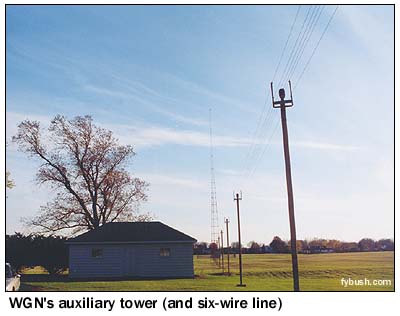 |
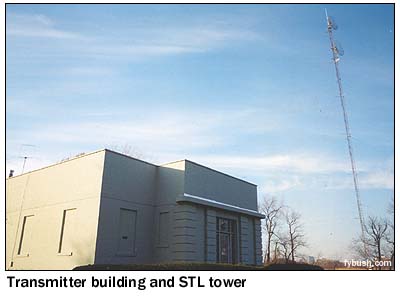 |
In addition to the main tower, WGN has an auxiliary tower at the south end of the property. Yup - that's old-school six-wire open transmission line heading out to the 250-foot self-supporting tower, but it's just there for decoration these days, having been replaced by more conventional buried transmission line. And look carefully at the STL tower above at right: though it's hard to see in this picture, that's a folded unipole antenna mounted on that tower to provide yet another worst-case transmission option.
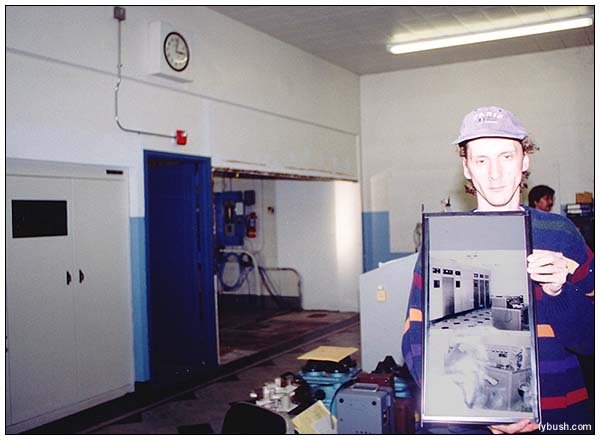
The main entrance to the transmitter these days is through the back door, which opens to the space behind the transmitters. At left in the photo above is the Harris DX50 that's been WGN's main transmitter. At center is the space where the Continental was and where the 3DX50 was going. And at right is our Indiana RadioWatch colleague Blaine Thompson holding up one of the site's prized artifacts: a photo showing the same room from the same spot back in the late thirties. That was a homebrew 50kW transmitter in the space where the Continental would later sit - and that's still the same clock on the wall and the same linoleum on the floor!
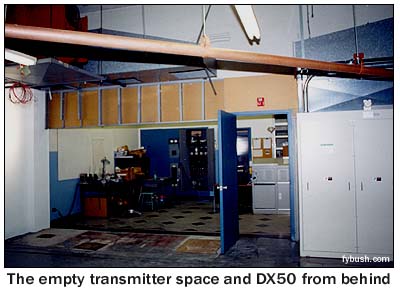 |
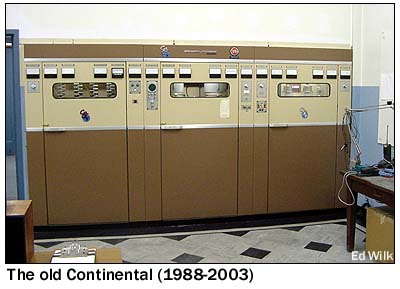 |
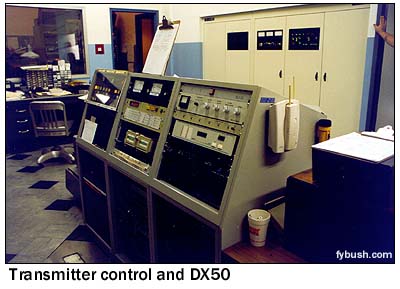 |
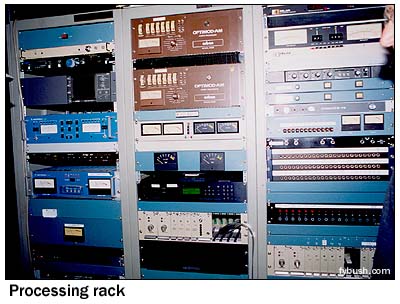 |
STL gear and transmitter control equipment sits in the center of the room, where engineers would once have worked around the clock supervising the transmitters; audio processing and more STL equipment sits in a rack in a room off the main transmitter area.
Next to those racks sits a folding table with some basic equipment - a simple mixing board, several cart machines, a cassette deck and two reel-to-reels. This is WGN's so-called "Y2K studio," assembled here in late 1999...just in case.
(Of course, the main WGN studios in the Tribune Tower building on Michigan Avenue functioned just fine!)
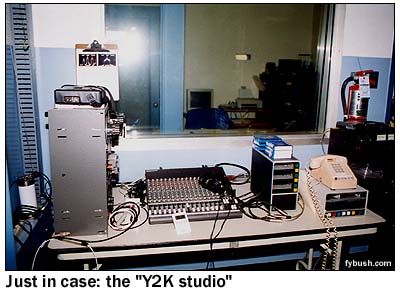 |
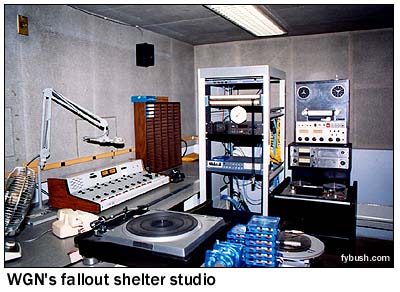 |
And there's yet another studio facility here - down in the basement, through a big metal door, sits the fallout shelter that was a common feature of the big transmitter sites of this vintage. This one has a particularly well-equipped studio facility, not to mention two big metal cabinets full of emergency food and water (vintage 1962), geiger counters and helpful booklets explaining what to do in the event of nuclear catastrophe.
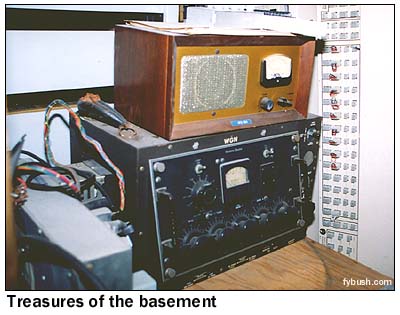 |
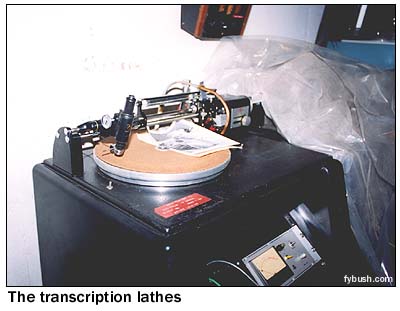 |
But the real treat is to be found in the main room in the basement, once home to the mighty power transformers that drove the old tube transmitters and now full of gear that's no longer needed downtown but is too interesting to be thrown away. That box above at left looks like an old mixing board for remote broadcasts - and those are two transcription lathes up against the wall in the photo at right.
"When do you think those were last used?" is the question the engineers ask our group, and the consensus is somewhere between 1950 and 1960. Turns out we were off by a full quarter-century - WGN was still cutting disks as late as 1985, which probably made it the last station in the country with a working recording lathe.
Why cut disks in an era when cart machines and reel-to-reel decks had long since become common, and when cheap digital audio recording was just a few years away? The answer lies in the black-and-white photo resting on the turntable: veteran WGN morning man Wally Phillips, who joined WGN in 1956 and stayed there until 1998. Phillips liked to do "bits" on his show in which he exchanged dialogue with recorded sound bites (not to mention talking back to recorded ads), and it was easier for his engineers to lift a needle off a disk, apparently, than to try to cue up carts to the exact bit Wally needed at a moment's notice. (It didn't come cheap, either; at the end, WGN was spending more than $20,000 a year keeping these machines maintained and supplied with blank disks, but that was a pittance compared with the huge revenues Phillips' show brought in.)
And with that nifty bit of history, we bade farewell to Ed and Jim and headed out for the long trek back to Indiana and eventually back home (and with a long list of additional Chicago sites to visit on a future trip!)
Tower Site Calendar 2004 is NOW SHIPPING! All orders placed by Wednesday, December 31 have now been shipped - and if you haven't yet ordered, what are you waiting for? Click here for ordering information!
- Previous Site of the Week: Three Chicago Studios
- Next Week: TBA
- Site of the Week INDEX!
- How can you help support Site of the Week? Click here!
- Submit your suggestions for a future Site of the Week!
